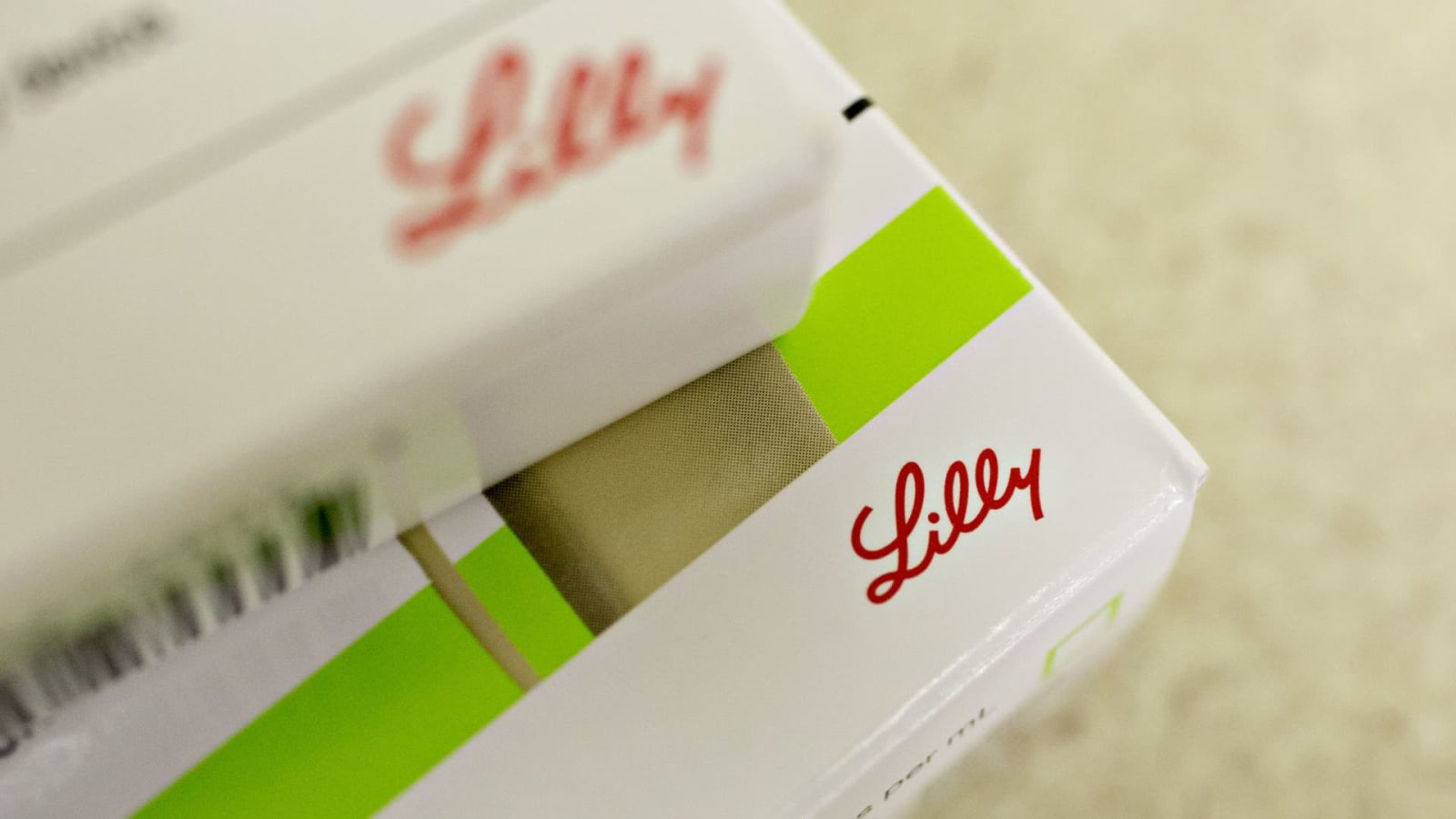Eli Lilly (LLY) is wisely broadening out its drug pipeline through a series of acquisitions of smaller companies – the most recent of which was disclosed earlier this week and should strengthen the Club holding’s efforts to develop cancer treatments. Lilly’s planned $1.4 billion deal to buy Point Biopharma (PNT), announced Tuesday, follows a busy summer for the Indianapolis-based pharmaceuticals giant, during which it bought three other experimental drug firms. Those takeovers help fortify Lilly’s positioning around treatments for obesity, diabetes and immunologic conditions such as psoriasis. To be sure, the acquisition spree does not change Lilly’s near-term revenue trajectory. The projected growth should still be driven by Mounjaro – a type-2 diabetes drug that’s expected to be approved to treat obesity by year-end – and to a lesser extent Alzheimer’s treatment donanemab , which U.S. regulators are expected to make a decision on in the coming months. Jim Cramer has said Mounjaro may eventually become the best-selling drug of all time. Nevertheless, Eli Lilly’s relatively inexpensive deals this year should be viewed in a favorable light. In the pharmaceutical industry, companies are required to balance the present and the prospective, looking not only a few quarters ahead but many years down the line, too. For Lilly, that means spending to support the broader rollout of Mounjaro and the likely commercial launch of donanemab – to say nothing of other growth products like breast-cancer therapy Verzenio – while also investing in experimental research. While the latter investments are risky and may never yield an application with the U.S. Food and Drug Administration, they’re necessary to stay competitive. “M & A is not really driving [Lilly’s] business,” BMO Capital Markets analyst Evan Seigerman said in an interview. Still, he said it’s “healthy” for a company like Eli Lilly — valued over $500 billion, as of Thursday — to be executing smaller deals. “They can still put their mark on an asset or a constellation of drugs,” said Seigerman, who has a buy rating and $633-per-share price target on Eli Lilly stock. “They’re not buying revenue, per say. I don’t love it when a company is a revenue aggregator…they’re buying earlier stage products that they can shape the development of, and then they can commercialize,” he added. LLY 1Y mountain Eli Lilly’s stock performance over the past 12 months. Details on the deals The three companies Eli Lilly bought this summer have drugs in various stages of the clinical development process. Obesity-focused Versanis Bio is actively studying its primary compound in a mid-stage trial, assessing whether it can help patients lose more body fat while maintaining muscle mass tissue when taken alongside another type of drug known as GLP-1s. Mounjaro, for example, is a GLP-1. Lilly said it could pay Versanis shareholders up to $1.93 billion if development and revenue milestones are met. Immunology-focused Dice Therapeutics, which develops oral therapies for chronic autoimmune and inflammatory diseases, also has its lead drug candidate in a mid-stage study . That trial, to determine its safety and effectiveness in treating moderate-to-severe plaque psoriasis, is expected to be completed next summer. Lilly’s acquisition of Dice valued the company at approximately $2.4 billion . Meanwhile, Siligon Therapeutics’ primary asset – developed using cell-therapy technology to treat type-1 diabetes – is earlier stage than that of Versanis and Dice, having not yet been entered into human trials, according to the company. Lilly and Sigilon had collaborated together since 2018. Lilly paid nearly $35 million to acquire all Sigilon’s outstanding shares. If certain milestones are met, Lilly could end up paying as much as $309.6 million to Sigilon shareholders. This week’s takeover target, Point Biopharma, is the acquisition whose main drug asset is furthest along, with a late-stage trial underway for a radiopharmaceutical therapy to treat prostate cancer . Lilly also made a major bet on cancer in 2019, when it bought Loxo Oncology for $8 billion , which helped the company usher in a strategy shift around the disease. Eli Lilly’s four announced acquisitions in 2023 represent an increase in activity compared with last year, when the Club holding bought just one earlier-stage firm. That company, Akuous, uses gene therapy to develop treatments for genetically defined hearing loss. It is currently recruiting participants for two trials, according to a Department of Health and Human Services. In general, one factor that could be boosting deal-making is an economic picture that’s pressured the value of startups and raised the cost of capital for those firms. “Valuations have come in, so there’s probably good deals to be found,” BMO’s Seigerman said. Seigerman said Lilly’s heightened M & A activity, in particular, may be aided by the bright prospects of Mounjaro, which has the scientific name of tirzepatide, and donanemab. “Given the potential for tirzepatide and donanemab, they’re feeling good about how they can spend money,” Seigerman said. “Their stock is really high; they generate a lot of cash flow. So, they can really invest in the business beyond” the drug categories to which Mounjaro and donanemab belong, he explained. Eli Lilly has next-generation assets in those categories, including a weight-loss pill that demonstrated impressive efficacy in a mid-stage study released in June , and an Alzheimer’s therapy, remternetug, that recently entered late-stage trials. But Lilly’s takeovers over the past year are mostly concentrated outside those drug classes – including Versanis Bio, whose main drug asset should be viewed as a complement to tirzepatide and other GLP-1s. Dice Therapeutics, meanwhile, will add to Eli Lilly’s efforts in immunology, an area of increasing focus for the pharmaceuticals firm. Bottom line Eli Lilly’s stellar pipeline is what first attracted us to the stock on the belief it would drive multiple years of revenue growth. Nothing has shaken us from that thesis over the past two years, and we’re closely anticipating the FDA’s expected approvals on Mounjaro for obesity and donanemab for Alzheimer’s by year-end. With its recent deals, Eli Lilly wisely adds more irons in the fire, even if it will take time to see the ultimate impact on revenues. In the near term, though, they may result in a noisy third-quarter earnings report as Eli Lilly records the acquisitions. Specifically, the Club holding’s in-process research and development, or IPR & D, expenses are likely to be elevated and hurt earnings-per-share on the basis of generally accepted accounting principles (GAAP). But that would simply reflect accounting and wouldn’t demonstrate any weakness in Lilly’s fundamentals. Eli Lilly’s stock has grown more attractive since Sept. 12, when we locked in profits of roughly 140% on shares we purchased in late 2021 and January 2022. In the intervening weeks, the stock has retreated about 10%. Lilly’s strong year-to-date gains of more than 47% and high valuation relative to large-cap pharmaceutical peers leaves its stock vulnerable to further declines if the 10-year Treasury yield continues to march higher . But in that event, we’d likely step in to buy back some of the shares we sold last month. (Jim Cramer’s Charitable Trust is long LLY. See here for a full list of the stocks.) As a subscriber to the CNBC Investing Club with Jim Cramer, you will receive a trade alert before Jim makes a trade. Jim waits 45 minutes after sending a trade alert before buying or selling a stock in his charitable trust’s portfolio. If Jim has talked about a stock on CNBC TV, he waits 72 hours after issuing the trade alert before executing the trade. THE ABOVE INVESTING CLUB INFORMATION IS SUBJECT TO OUR TERMS AND CONDITIONS AND PRIVACY POLICY , TOGETHER WITH OUR DISCLAIMER . NO FIDUCIARY OBLIGATION OR DUTY EXISTS, OR IS CREATED, BY VIRTUE OF YOUR RECEIPT OF ANY INFORMATION PROVIDED IN CONNECTION WITH THE INVESTING CLUB. NO SPECIFIC OUTCOME OR PROFIT IS GUARANTEED.
Eli Lilly (LLY) is wisely broadening out its drug pipeline through a series of acquisitions of smaller companies – the most recent of which was disclosed earlier this week and should strengthen the Club holding’s efforts to develop cancer treatments.
Read the full article here










Leave a Reply